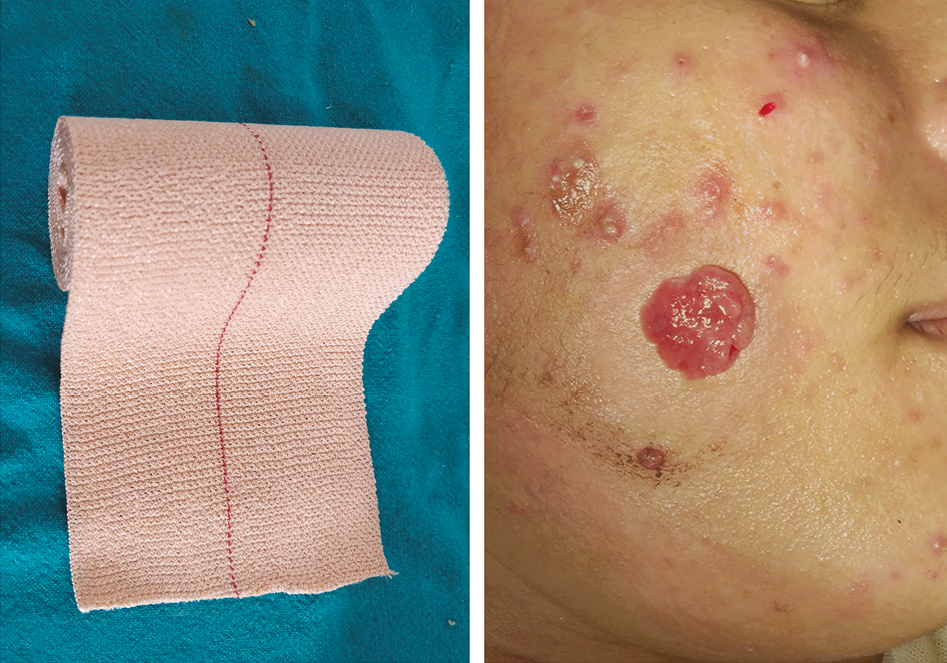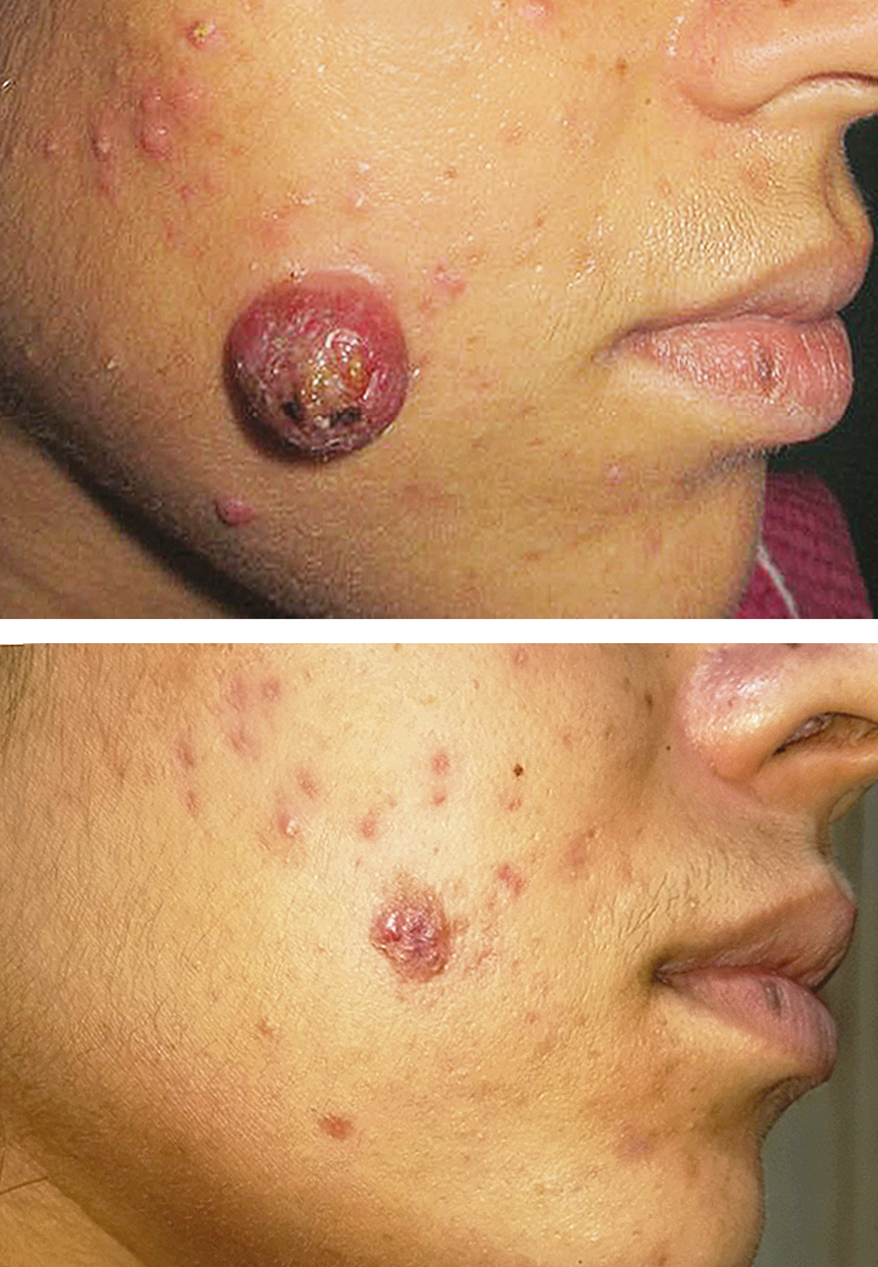Translate this page into:
Pressure Therapy for Pyogenic Granuloma
Address for correspondence: Dr. Mriganka Mehra, Department of Dermatology, Shri Ram Murti Smarak Institute of Medical Sciences, Bareilly 243202, Uttar Pradesh, India. E-mail: mrigankamehra1@gmail.com
This article was originally published by Wolters Kluwer - Medknow and was migrated to Scientific Scholar after the change of Publisher.
Abstract
Abstract
Pyogenic granuloma is a benign vascular tumor, with a tendency to bleed on manipulation. A young female presented to us with a disfiguring facial pyogenic granuloma. We adopted a novel approach using pressure therapy to treat the same. The use of an elastic adhesive bandage reduced the size and vascularity of the lesion, following which laser ablation was done with minimal bleeding and scarring. This is a simple, inexpensive method to approach large and disfiguring pyogenic granulomas.
Keywords
Dermatology
pyogenic granuloma
scar
surgery
INTRODUCTION
Pyogenic granuloma is a benign vascular tumor that occurs on the skin and mucous membranes, which arises spontaneously in sites of injury or within capillary malformations. They are cosmetically disfiguring when present over the face and have a tendency to bleed profusely.[1]
CLINICAL PRESENTATION
A 24-year-old woman presented with a reddish raised lesion over the right cheek. There was a history of an acne lesion at the site, which the patient scratched incessantly. This could be the possible etiology of the pyogenic granuloma. It progressively became larger and nodular over a span of three months. The lesion was asymptomatic but caused significant psychological morbidity to the patient. The lesion bled easily upon manipulation. The diagnosis was clinical, aided by dermoscopy. On dermoscopy, we found homogenously red areas with white rail lines and ulceration. We were unable to perform an excisional biopsy because of the procedure performed that reduced the size and vascularity of the lesion.
TREATMENT
Because of the cosmetically sensitive location of the lesion and the patient’s apprehensions regarding scarring, we adopted a novel approach in the form of pressure therapy to reduce vascularity and the size of the tumor. This was done by the firm application of an elastic adhesive bandage placed over the gauze piece, covering the lesions for weekly intervals [Figure 1]. We ensured that the bandage was tightly applied, and upon removal, we checked that it stayed in place, maintaining requisite pressure over the lesion. After two weeks, this led to a marked reduction in size and vascularity, which aided in the complete removal of the lesion with minimal scarring [Figure 2]. The significantly smaller lesion was easily ablated with CO2 laser, with minimal bleeding. No recurrence was noted with this procedure upon a follow-up of three months. This is a simple and effective method, which is free from any side effects.

- Pyogenic granuloma—decreased vascularity and size after the use of pressure therapy with an elastic adhesive bandage

- Disfiguring pyogenic granuloma removed with minimal scar
DISCUSSION
Pyogenic granuloma is a benign vascular lesion of the skin and mucosal areas with unidentified etiology. The mainstay of treatment are lasers. Other treatment modalities include excision, cryotherapy, chemical cauterization, sclerotherapy, topical imiquimod, or intralesional bleomycin.[2345] The main concern with these is bleeding, postprocedure scarring, or cutaneous necrosis.[2] Keeping all these factors in mind, pressure therapy was adopted as a modality of initial treatment in the large disfiguring pyogenic granuloma. This led to a marked reduction in size and vascularity, which aided in the complete removal of the lesion with minimal scarring. We propose that the firm and sustained pressure over the pyogenic granuloma led to a collapse in the proliferating vessels in the lesion. This eventually led to a decrease in size and vascularity. To the best of our knowledge, there are no prior reports of the use of this modality of treatment in such cases.
Declaration of patient consent
The authors certify that they have obtained all appropriate patient consent forms. In the form the patient(s) has/have given his/her/their consent for his/her/their images and other clinical information to be reported in the journal. The patients understand that their names and initials will not be published and due efforts will be made to conceal their identity, but anonymity cannot be guaranteed.
Financial support and sponsorship
Nil.
Conflicts of interest
There are no conflicts of interest.
REFERENCES
- Pyogenic granuloma—The quest for optimum treatment: Audit of treatment of 408 cases. J Plast Reconstr Aesthet Surg. 2007;60:1030-5.
- [Google Scholar]
- CO2 laser excision of a pyogenic granuloma associated with dental implants: A case report and review of the literature. Photomed Laser Surg. 2016;34:425-31.
- [Google Scholar]
- Versatility of the Nd-YAG laser in the treatment of facial vascular alterations. Kosmet Med. 2008;29:134-7.
- [Google Scholar]
- Pyogenic granuloma in children: Treatment with topical imiquimod. Australas J Dermatol. 2007;48:217-20.
- [Google Scholar]
- Treatment of pyogenic granuloma by sodium tetradecyl sulfate sclerotherapy. Arch Dermatol. 2005;141:644-6.
- [Google Scholar]






